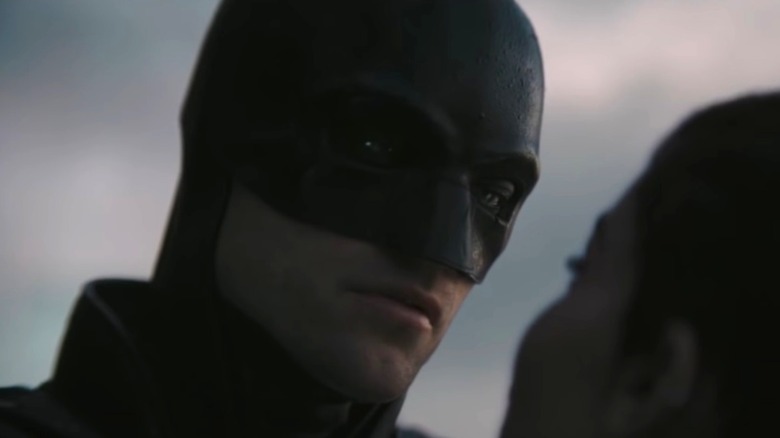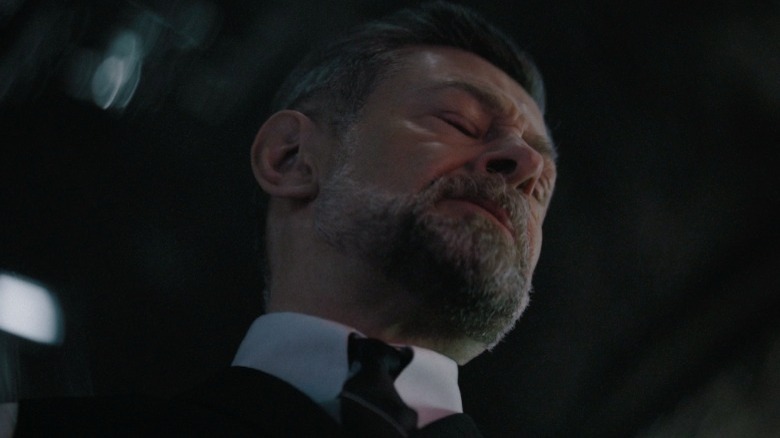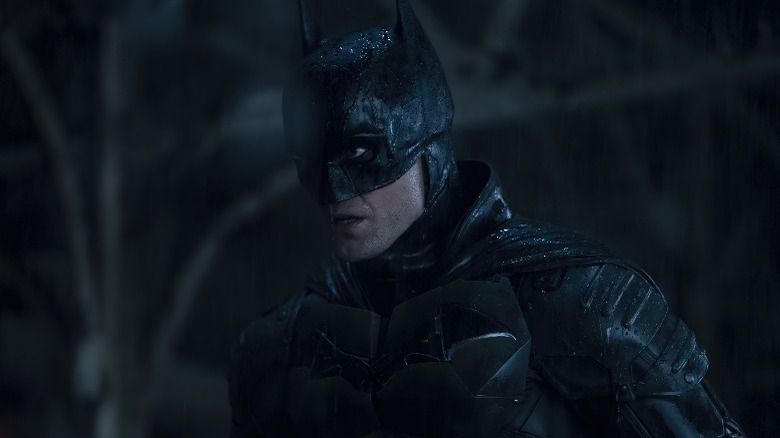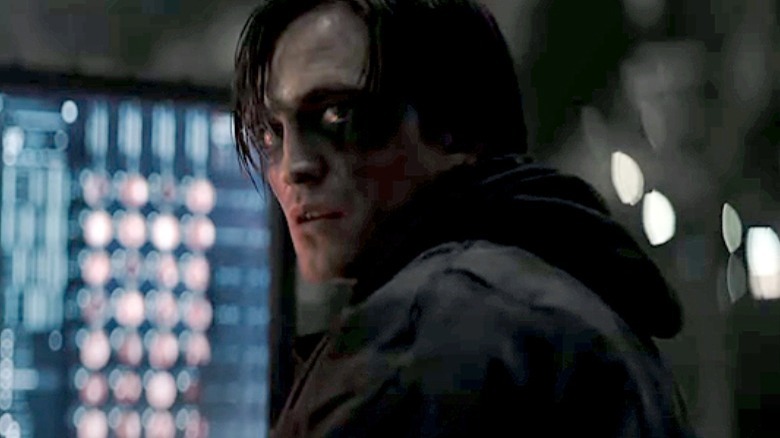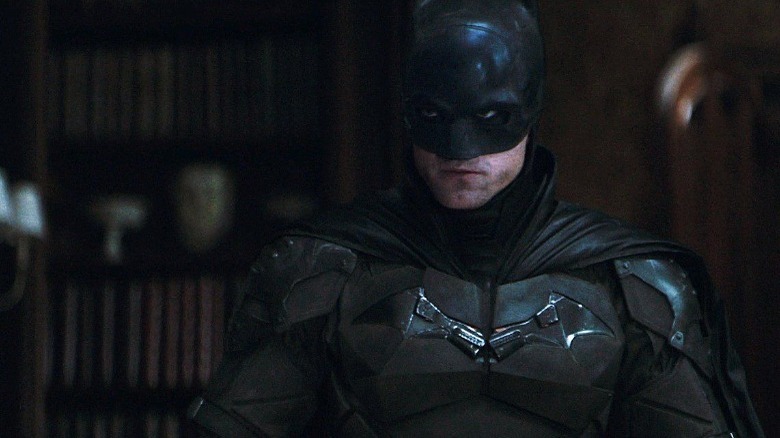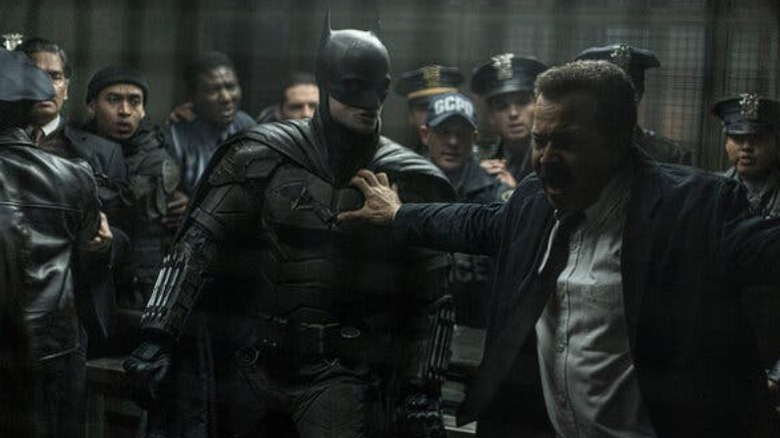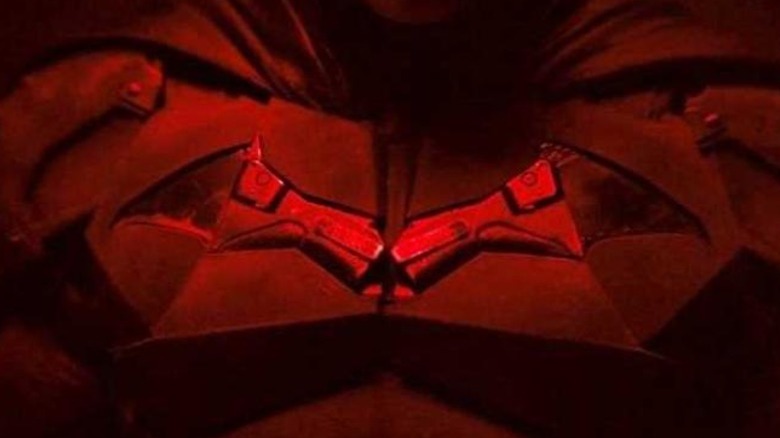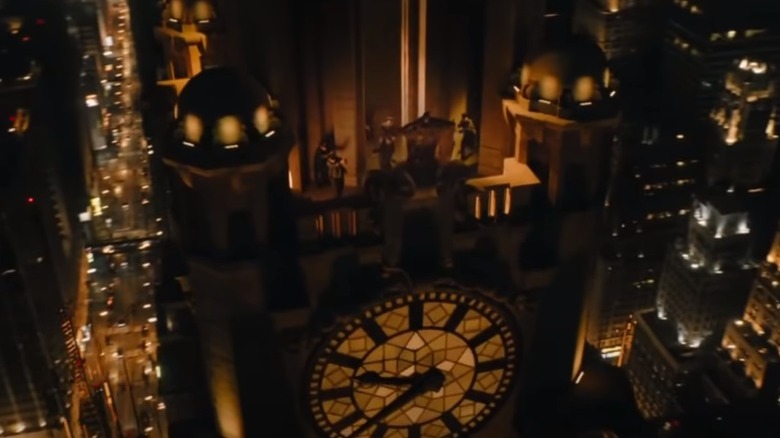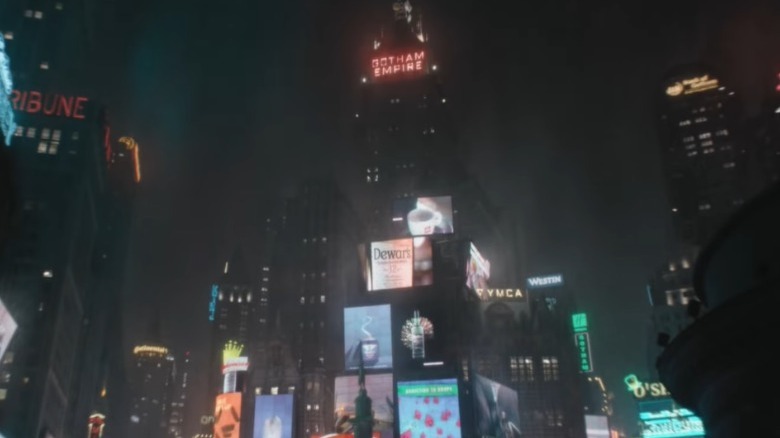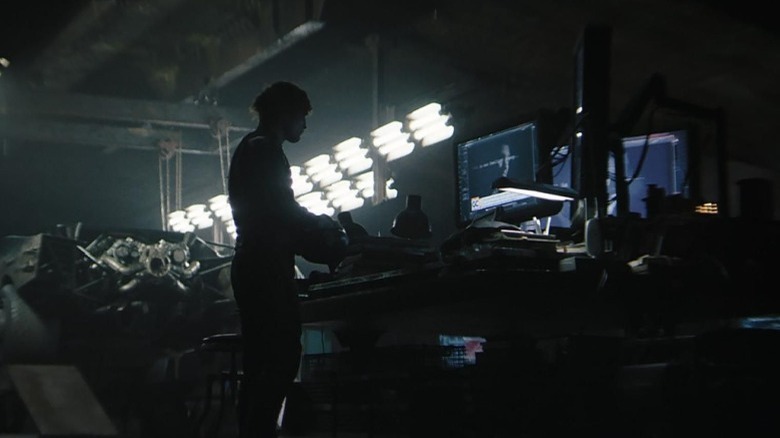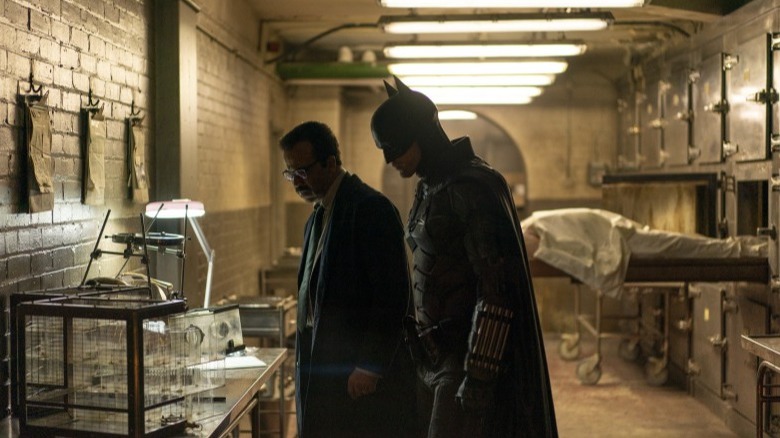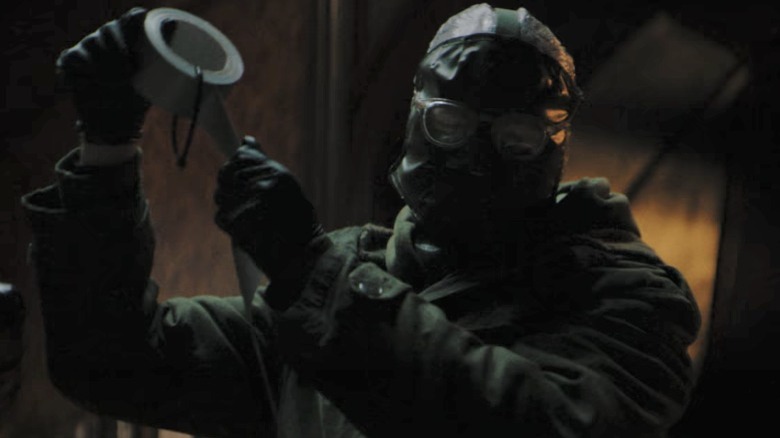All The Ways Pattinson's Batman Was Different From Others
Receiving a knuckle sandwich for their dirty deeds is the least criminals have to fear from the newest incarnation of Batman on the big screen. In "The Batman," the Caped Crusader is merciless and ensures that all evil-doers he encounters find their way to a hospital bed. While crime is still rampant in Gotham, largely due to corruption and a toxic atmosphere created by city leadership, criminals fear the Bat. This version of the character comes from a far darker place than audiences have seen before in live-action. Mentally, Bruce Wayne is so greatly affected by his personal tragedy that it ultimately distorts Batman's traditional mission –- at least until the vigilante begins evolving into the hero we know him to be.
"The Batman" is a thrilling narrative steeped in horror, intrigue, and flashy action sequences. Robert Pattinson, Zoë Kravitz, and Paul Dano bring the gravitas necessary and a high level of thespian acuity to their roles to create one of the most exhilarating tales of the Dark Knight audiences have ever witnessed. Whether it's the intro scene seemingly ripped out of a horror film or Batman truly working a sprawling criminal case like a professional detective, "The Batman" offers plenty of fresh ideas for this adventure that sets itself apart from previous live-action outings. Let's dive into some of the ways Robert Pattinson's take on the famous vigilante differs from other iterations of the character to don the cowl on the big screen.
Alfred trained Bruce
Batman's combat prowess is one of the most notable aspects of the character, alongside his intellect and array of gadgetry. While the Batman films of the '90s never really depicted a young Bruce Wayne training to become Batman, Christopher Nolan's "Batman Begins" certainly did. In that film, as in the comics, Bruce leaves Gotham to train among the world's most formidable fighters. Not only does he learn how to fight, but he learns how to survive. Batman travels the world, getting himself locked away in prisons to witness the criminal element up close. He studies many fighting styles and even fights criminals for practice. Eventually, he lands in Ra's Al Ghul's dojo and receives advanced training from the League of Shadows.
"The Batman" depicts a version of Bruce Wayne who has no trepidation when tackling a large numbers of assailants at once with nothing but his fists. He's fast, calculating, and merciless. While this film isn't an origin story for the hero, we do learn that the Caped Crusader was actually trained by Alfred Pennyworth. Furthermore, Alfred even states that he should have protected Thomas and Martha, leaving us to believe that he may have been part of the family security detail rather than just a butler. In the "Batman: Earth One" graphic novels, Alfred is a former in the S.A.S. who teaches Bruce everything he knows, meaning this idea isn't new by any stretch — but it absolutely offers a fresh perspective in the live-action arena.
At first, Batman is motivated by hate
Batman embarks on a crusade at the beginning of "The Batman." He's been at it for two years, as he explains in a voiceover at the beginning of the film, and admits that he doesn't know if he's making a difference. He does know one thing, however. Criminals fear the dark. They know Batman is prowling the streets of Gotham. Should they meet him, they'll experience a world of pain.
While Batman doesn't kill, he has no objections to physically maiming his opposition. His attitude toward the innocent is aloof at best. Batman's goal isn't necessarily to save a poor man from an assault by gangsters. It's to punish the thugs for their crimes. Later, he's more concerned about retrieving intel on criminal suspects than helping Selina Kyle find her friend whose life hangs in the balance.
Ultimately, Batman is motivated by hatred. His parents were taken from him at a young age, and all he wants to do is see criminals, like his parents' killer, suffer. Instantly, this makes this version of the character a few shades darker than even the Nolan incarnation. By the time Christian Bale's Bruce Wayne is ready to don the cowl, he is long past his desire to kill the murderer of his parents and exact justice. Instead, he is focused on cleaning up the streets of Gotham. Pattinson's Batman isn't quite at that place yet, but he seems to approach it by the end of the film.
Batman is Bruce, and Bruce is Batman
Typically, Bruce Wayne is distinguished from his Batman persona as a wealthy playboy who lives in Wayne Manor. This disguise allows Bruce Wayne to operate in the public eye and even use his family's legendary wealth to aid his crusade and pursue philanthropic endeavors.
In "The Batman," Bruce does not seem particularly distinct from his vigilante counterpart. In fact, he's rarely in the public eye. When he emerges in the daylight tidied up in a suit for the Mayor's funeral, the press is startled by seeing the reclusive Bruce Wayne out and about. His demeanor is sullen and contemplative, not unlike his vigilante counterpart. Perhaps, it's difficult to really suspect the billionaire heir as the Caped Crusader simply because he doesn't often see the light of day -– at least in the public's perspective.
Regardless, Bruce hasn't locked down a means for separating himself from the Batman. Given that his outlook on his mission changes dramatically in the end in favor of providing the city with hope, perhaps Bruce will brush up on his social skills and engage with the public in the follow-up film.
Batman's armor is top-notch
Batman may be a superhero, but he is also just a man. A speeding bullet won't bounce off his chest like his DC Comics cohort, Superman. As such, Bruce Wayne depends on body armor to withstand any damage he might receive during his crusade. Pattinson's Batman excels in this arena, setting it apart from previous versions.
The Batsuits of the '90s were mostly designed for aesthetics, while Christopher Nolan's version of the character adapted real-world usage for every aspect of the suit. However, while Christian Bale's Batman could take a beating, his lightweight armor couldn't deflect rounds from high-powered firearms. While Ben Affleck's take on the character saw a Batman capable of deflecting smaller rounds of ammunition, he was susceptible to a nasty stab wound during a fight sequence in "Batman v Superman: Dawn of Justice."
Pattinson's Batman has armor plating capable of taking heat from automatic weapons, a close-range shotgun blast, and high-caliber sniper rifles. While Bruce can feel the impact of such weaponry, it does a stellar job protecting Batman from fatal wounds. In fact, the armor does such a great job that it's almost too unrealistic in a film aiming for a more grounded approach to the character. However, Batman does have contact lenses capable of streaming and recording video, and if this level of high-tech wizardry is possible in this world, maybe efficient yet breathable armor is also.
This Batman isn't shy about showing his face in public
Typically, Batman's operations are relegated to the shadows. He tends to aim for a certain mystique in the public eye that leads to potential bad actors always questioning his movements and motives. Previous films touched on the idea that Batman could take his work public, such as in "The Dark Knight," where Batman enters a nightclub to interrogate Sal Maroni. Then, of course, in the third act of "The Dark Knight Rises," he leads the police force in a daytime assault against Bane. Despite those moments, however, Batman's business hours are primarily at night.
However, Pattinson's Batman has no apprehension about entering the public domain dressed as the Dark Knight. We first see him enter the Iceberg Lounge to question Colin Farrell's Oz (the future Penguin) about the mayor's connections. The Iceberg Lounge is filled with dancers, bartenders, patrons, and gangsters who can all see the Batman walking around and interacting with Oz in plain view. He's also seen walking among the police precinct filled with cops.
In the film's final moments, Batman helps countless people out of the wreckage throughout the city and is seen in daylight on the morning newsreel providing humanitarian relief to victims. It's a visual most don't associate with the Dark Knight.
Batman's chest bat-symbol doubles as a tool
Batman's chest logo is iconic. Ever since his first appearance in comics as created by Bill Finger and Bob Kane, Batman has always had a bat symbol on his chest. In some comic book variations, special considerations were given to that symbol. For instance, Inverse notes that in "Detective Comics" #1000, a short story titled "Manufacture For Use" depicts Bruce tracking down the gun that killed his parents and purchasing it to melt it down for the armor plating on his chest symbol. It was a meaningful reclamation of the very weapon that once caused his tragedy and now has the new purpose of protecting him.
While early fan buzz speculated that Pattinson's Bat Symbol was the gun that killed his parents, this was not the case. Matt Reeves confirmed as much. He further stated, however, that he desired the chest piece to double as a tool or weapon which Batman can pull from his chest and use as a bladed tool to slice rope or other objects. In an interview with HeyUGuys, Reeves provided more context for the creative decision.
"It's not the gun. That was interesting that people were speculating that that's what it was. What people did happen on that's right is I wanted it to be not just an emblem, but I wanted it to be something tactical and functional ... That's actually a Glauca knife that he uses in a couple of places in the movie."
He glides using a wingsuit
The Dark Knight is known for being able to traverse the city by gliding with the use of his cape. However, while Wired reported that real-world science states creating a cape that glides is possible, landing from such a maneuver would lead to a swift death. However, that hasn't stopped Batman from defying gravity and the laws of physics time and time again on the silver screen.
"The Batman," however, aimed to squash that science-shattering dilemma by providing the hero with a means to slow down before hitting the ground. For starters, Batman's gliding capabilities are thanks to a true-to-life wingsuit that emerges from his Batsuit. After leaping, he must pull a parachute that decelerates him rapidly before touching down. That was the exact missing piece physicists claimed that made Batman's cape-gliding an unrealistic magic act.
Despite Batman's use of the wingsuit, he still has a rather rough landing when his parachute catches a bridge and smacks the hero into the ground painfully. Thankfully, he's got that sturdy armor to keep him safe.
Bruce Wayne lives in a skyscraper
Bruce Wayne is usually one of the two inhabitants of a massive mansion left behind by his parents. Wayne Manor has long been a staple of the Batman mythos as the decadent home of playboy Bruce Wayne that also masks his vigilantism and alter-ego. In "The Batman," however, Wayne Manor seemingly doesn't exist –- at least, not in the way we're used to. Bruce Wayne lives in Wayne Tower. The Riddler even mentions that the Waynes looked down upon Gotham, perhaps imagining them in their top story living quarters in Wayne Tower.
The decision to alter the Wayne home was ultimately made for one primary reason. As production designer James Chinlund and director Matt Reeves explained to Variety, the idea was to differentiate their Batman from previous versions of the character who resided on the outskirts of the city in their lofty estate, Wayne Manor. They wanted Bruce to truly be a part of Gotham City, and having him live in Wayne Tower situates him in the heart of the sprawling metropolis.
The Batcave is an abandoned subway station
Since Bruce Wayne doesn't live in the Wayne Manor, the Batcave isn't exactly what we remember, either. Typically, the Batcave is positioned just beneath the foundation of Wayne Manor and is Batman's true operating base. It contains all of his gadgets, suits, the Batcomputer, and, of course, the Batmobile. The Batcave is an iconic piece of the Batman mythos that is depicted in just about every Batman film. "The Dark Knight," however, showed us a temporary location Bruce utilized in a shipping yard while Wayne Manor was under reconstruction.
Instead of an actual cave, "The Batman" once again embraces a more real-world approach. With Bruce living in the heart of Gotham, his base of operations is now in an abandoned subway station that is, in essence, the Batcave. Unfortunately, we don't know too much about the station other than it was privately owned by the Wayne family. Like the Batcave, Bruce Wayne does keep his equipment, including the monstrous Batmobile, locked up in this faded alcove under the city.
Batman makes plenty of mistakes
Batman fans know that he ultimately becomes the pinnacle of human perfection as far as physicality, intellect, and moral integrity are concerned. He's so adept at combating criminals, including super-powered evil-doers, that the hero stands shoulder-to-shoulder with Superman and Wonder Woman despite not having any powers. He's a master strategist who is always thinking ten steps ahead. Batman has the gadgetry required for any job, always does his research, and knows what to expect in different situations. Beyond that, he didn't also earn the title "world's greatest detective" for nothing — it's usually extremely difficult to catch Batman off guard.
"The Batman" presents a vigilante who has only been operating for two years. While super-powered beings may (or may not) exist in Matt Reeves' version of Batman's world, the Dark Knight is still learning to become the best he can be to thwart any threat. The film depicts a Batman who's highly capable but still an amateur compared to the wiser and older depictions in comic books and on screen. In combat, he makes mistakes, often miscalculating and sometimes taking hefty blows from baddies. While he capably solves the riddles the sinister Riddler leaves behind, he misses the big picture that the Riddler has planned for Gotham City. This Batman's fallibility makes him far more relatable to audiences.
He's far more engaged in detective work
Batman is the world's greatest detective, according to DC Comics. While he's never been referred to as a genius at the level of someone like Lex Luthor, his mind is so disciplined that he can shut off the noise around him and decipher clues and puzzles left by masterminds. In the comic books, he's often seen performing detective work just as much as he is shown physically engaging the bad guys. Detective work is in his nature, which is why he first appeared in "Detective Comics."
While previous Batman films have shown the Dark Knight running evidence through his Batcomputer and piecing data together, none have depicted Batman following the trail of a full-blown serial killer cold case. In fact, "The Batman" was compared to investigative thrillers like "Se7en" and "Zodiac." The Riddler is the perfect villain to leave an enigmatic puzzle in his wake as he moves from victim to victim, Batman is the right person to aptly solve those riddles to gain more intel, and it's refreshing to see the Dark Knight solve crimes on the big screen.
